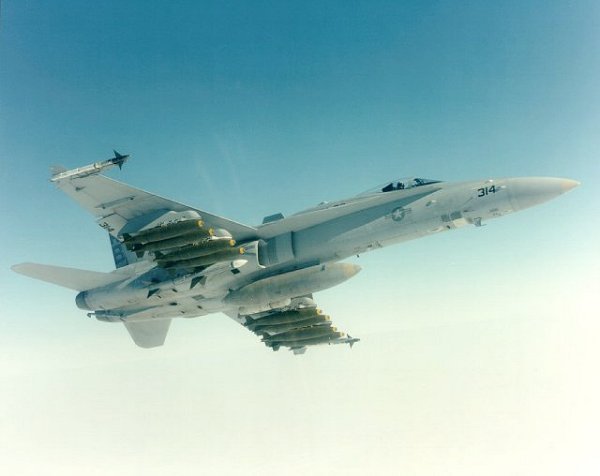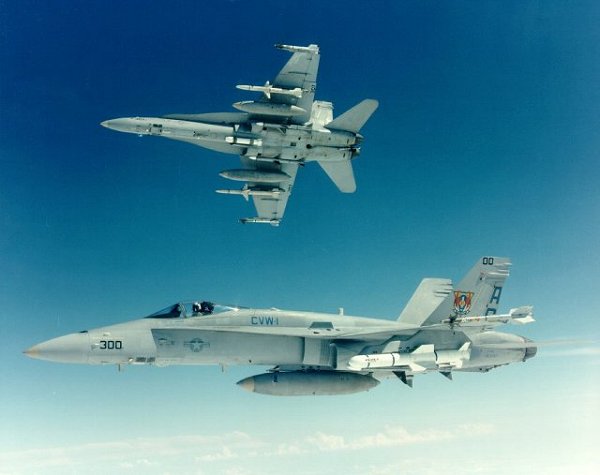No sé para que se rompen los cuernos viendo que usar para extender el radio de acción de los F-16, si cuando asumió esta administración, los EE.UU, no solo pusieron a disposición un lote de F-16 SIPP, si no que también dos KC-135, y algunas cosas mas, de las cuales la FAA, anda muy necesitada.
Estás usando un navegador obsoleto. No se pueden mostrar estos u otros sitios web correctamente.
Se debe actualizar o usar un navegador alternativo.
Se debe actualizar o usar un navegador alternativo.
Rumores y discusión sobre el próximo multirrol que no fue para la FAA
- Tema iniciado Cocker
- Fecha de inicio
Coincido con vos, pero el punto es que para mi son un derivado de lo que se pensó como LIFT, ergo lo son aunque puedan potencialmente evolucionar en capacidades.La FAA no quiere un LIFT sino una aeronave de ataque ligera con capacidad secundaria de entrenamiento avanzado. Parece un juego de palabras pero no lo es. Creo que todos sabemos la diferencia entre un F-5 y un T-38.
Yo también. Pero el M-346 en la versión FA.
Ya que te interesa tanto el tema de los reabastecedores escojo al ExtenderNo sé para que se rompen los cuernos viendo que usar para extender el radio de acción de los F-16, si cuando asumió esta administración, los EE.UU, no solo pusieron a disposición un lote de F-16 SIPP, si no que también dos KC-135, y algunas cosas mas, de las cuales la FAA, anda muy necesitada.
Eduardo Moretti
Colaborador
Ya mencioné que hay planes por los C-295, un par de C-130 adicionales para modernizar aquí, un caza o un avión de combate ligero y hasta alguna idea de como reemplazar los Pucará, pero nadie puede ignorar que el país está fundido y claramente, las prioridades son otras.
Si el actual Gobierno pudiera concretar esto aquí descripto, además de las adquisiciones que ya sabemos que hizo en estos 3 años anteriores, no estaría nada mal. Sobre todo teniendo en cuanta los 16 años anteriores a su asunción (1999 al 2015), que fuero muy malos -por decir poco- en materia militar.
El tema es que en el actual contexto económico, y con elecciones tan cercanas, me da la sensación que este será un año con muy pocas novedades de adquisiciones, más allá de las necesidades acuciantes de la FAA. Ojalá me equivoque, y al menos algo de esto se empiece a concretar.
MichelunNo sé para que se rompen los cuernos viendo que usar para extender el radio de acción de los F-16, si cuando asumió esta administración, los EE.UU, no solo pusieron a disposición un lote de F-16 SIPP, si no que también dos KC-135, y algunas cosas mas, de las cuales la FAA, anda muy necesitada.
Que significa la sigla SIPP, asi busco algo de info?
Gracias
No sé para que se rompen los cuernos viendo que usar para extender el radio de acción de los F-16, si cuando asumió esta administración, los EE.UU, no solo pusieron a disposición un lote de F-16 SIPP, si no que también dos KC-135, y algunas cosas mas, de las cuales la FAA, anda muy necesitada.
Michelun
Que significa la sigla SIPP, asi busco algo de info?
Gracias
Es CCIP (Common Configuration Implementation Program) que fue un programa de modernización aplicado a los Block 40/42/50/52 de la USAF, Corea del Sur y creo Turquía.
Kfir y JF-17 ya han sido descartados.
Entre el M-346 y el FA-50, la FAA prefiere a éste ultimo por su capacidad supersónica, pero el coreano se quedó muy atrasado y para cumplir los requerimientos de la FAA se requiere de mucho dinero en certificaciones y homologaciones. No tiene bus 1760, no tiene homologado barquillas EO/IR, ni un sistema defensivo, ni capacidad IFR, ni casco con mira ni un sistema de enlace de datos ni armamento aire-suelo guiado. Además la configuración del cockpit ( dos pantallas) ya quedó desfasada frente al Texan II y Pampa III.
A barajar y dar de nuevo.....
Kfy descartado? Seras almuerzo del leon de finback.
Saldra mas barato ponerle lo que le falta al koereano o hacer supersonico al 346? Sino hay que descartar a los 2 por no cumplir los requisitos...o bien declarar requisitos nuevos....en la proxima aeroespacio saldra el nuevo pulqui cincooooooomil.
Pregunta: Cuántas veces el F-16 fue ofrecido ? Tengo entendido que durante la época de Menem hubo interés pero la respuesta fue un "no, tal vez en otro momento" . . .
Cordiales saludos
Cordiales saludos
Una exageración. Eso lleva como el doble de combustible que el KC-135 o el nuevo KC-46AYa que te interesa tanto el tema de los reabastecedores escojo al Extender
Estas pensando lo mismo que yo me parece....Navy retires F/A-18C Hornet from combat as F-35C nears operational status

Cpl. Dylan Lippard observes a replenishment-at-sea last month from atop an F/A-18C Hornet on the flight deck of the aircraft carrier USS Theodore Roosevelt.
ALEX CORONA/U.S. NAVY PHOTO
By CAITLIN DOORNBOS | STARS AND STRIPESPublished: April 20, 2018
It’s the end of an era for the Navy’s F/A-18C Hornet; officials announced the jet’s recently completed deployment aboard the USS Carl Vinson was its last.
The service recently told Stars and Stripes it will no longer use the jet in combat or regular deployments, but will find other uses for the attack aircraft first deployed decades ago.
Though the three-month mission that ended March 12 was the Hornet’s final full deployment, Strike Fighter Squadron 34 will fly the jets in the 25-nation Rim of the Pacific exercise this summer, said Lt. j.g. Emily Judstra, a Naval Air Forces Pacific Fleet spokeswoman.
After that, the Hornets will mainly be used in demonstrations and training with the Blue Angels, at the Naval Aviation Warfighting Development Center and in reserve squadrons, she said.
The San Diego-based VFA-34 will be the last squadron to transition to the F/A-18E Super Hornets when it does so next February, Judstra said.
An F/A-18C Hornet takes off earlier this year from the aircraft carrier USS Carl Vinson in the Pacific Ocean.

SEAN CASTELLANO/U.S. NAVY PHOTO
The Hornet’s similarly looking successor, the F/A-18E/F Super Hornet, will continue to be used in deployments and combat.
The Super Hornet, which was rolled out in 1999, is about 25 percent larger with “increased maneuverability, range, payload and more powerful engines” than its predecessor, according to Boeing.
The F/A-18C’s departure creates room for newer fighter jets on flight decks. The Navy’s F-35C Lightning II is coming closer to operational status, completing fleet carrier qualifications last month.
The service said last fall that its version of the F-35 — which has drawn scrutiny over a predicted $1 trillion-plus cost of operations over its expected 60-year life span — will reach initial operational capacity this year.
The Hornet’s first C models entered active duty in 1987 and cost $29 million each. In its earlier years, the jet “[broke] all records for tactical aircraft in availability, reliability and maintainability,” the Navy said
https://www.stripes.com/news/us/nav...at-as-f-35c-nears-operational-status-1.522981
+
Derruido
Colaborador
El tema es que después olvidate de que compren algo más. Vas a morir con el Lift. Porque el político no lo va a entender como un entrenador sinó como un avión de combate. Entonces si acá se compra un Lift, el político y la gente lo va a ver como un avión definitivo y no con un escalón para..........Ya lo vimos en Malvinas al tema para saber como es.
Si compramos un LIFT hay que sincerar que es un LIFT y que la idea es recuperar la cantidad de pilotos. Con los Texan, Pampa III y estos vamos a tener una buena flota de entrenadores.
Yo por eso prefiero el M-346.
Besos
Derruido
Colaborador
Que estamos hablando de un avión de combate y no de uno de juguete.Estas pensando lo mismo que yo me parece....

Derruido
Colaborador
Para eso le ponés los tanques conformables en el lomo y tanques más pequeños. Esos son tan grandes que solo se justifican para hacer un viaje de largo aliento, sin tener en mente una acción de combate. Esa carga de combustible, resta carga de armamento. Y seguramente, habría que largarlos en el vuelo para entrar en combate.Los del F-16 griego creo que son de 370 galones. Sólo los Block 50/52 pueden transportar los monstruosos de 600 galones

Besos
Es CCIP (Common Configuration Implementation Program) que fue un programa de modernización aplicado a los Block 40/42/50/52 de la USAF, Corea del Sur y creo Turquía.
Michelun
Que significa la sigla SIPP, asi busco algo de info?
Gracias
Bueno. ahí Spirit lo escribió bien.

Derruido
Colaborador
Hacé silencio quieres? dejanos a los que estamos embutidos en el temaUna exageración. Eso lleva como el doble de combustible que el KC-135 o el nuevo KC-46A
Última edición:
Derruido
Colaborador
Temas similares
- Respuestas
- 12
- Visitas
- 8K
- Respuestas
- 54
- Visitas
- 13K
- Cerrado
- Respuestas
- 1
- Visitas
- 5K
S




